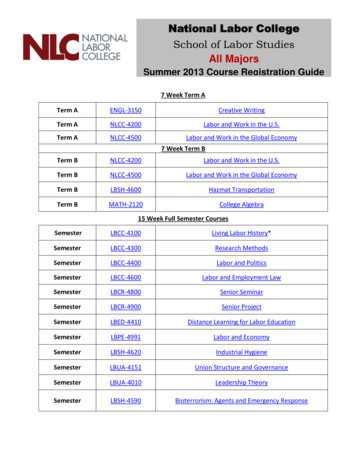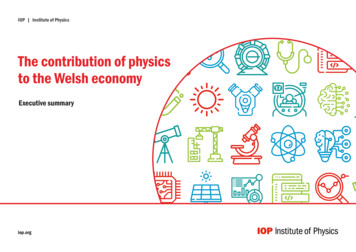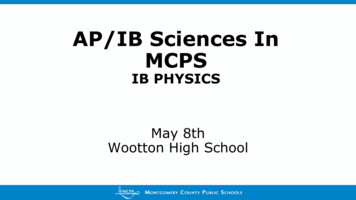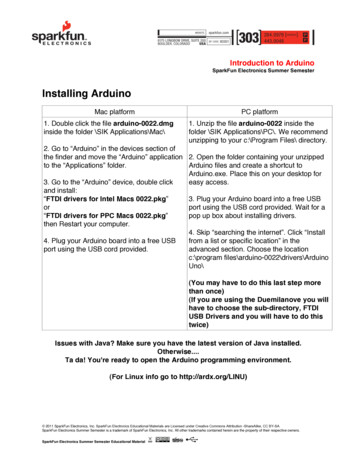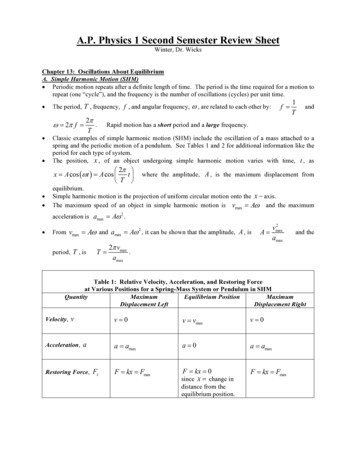
Transcription
A.P. Physics 1 Second Semester Review SheetWinter, Dr. WicksChapter 13: Oscillations About EquilibriumA. Simple Harmonic Motion (SHM) Periodic motion repeats after a definite length of time. The period is the time required for a motion torepeat (one “cycle”), and the frequency is the number of oscillations (cycles) per unit time. The period, T , frequency, f , and angular frequency,w 2p f 2p.Tf 1TandRapid motion has a short period and a large frequency.Classic examples of simple harmonic motion (SHM) include the oscillation of a mass attached to aspring and the periodic motion of a pendulum. See Tables 1 and 2 for additional information like theperiod for each type of system.The position, x , of an object undergoing simple harmonic motion varies with time, t , asæ 2px A cos (wt ) A cos çè T w , are related to each other by:öt øwhere the amplitude, A , is the maximum displacement fromequilibrium.Simple harmonic motion is the projection of uniform circular motion onto the x - axis.The maximum speed of an object in simple harmonic motion is vmax Aw and the maximumacceleration is amax Aw 2 . From vmax Aw and amax Aw 2 , it can be shown that the amplitude, A , isperiod, T , isT A 2p vmax.amax2vmaxamaxand theTable 1: Relative Velocity, Acceleration, and Restoring Forceat Various Positions for a Spring-Mass System or Pendulum in SHMQuantityMaximumEquilibrium PositionMaximumDisplacement LeftDisplacement RightVelocity, vv 0v vmaxv 0Acceleration, aa amaxa 0a amaxRestoring Force, FxF kx FmaxF kx 0F kx Fmaxsince x change indistance from theequilibrium position.
A.P. Physics 1 Second Semester Review Sheet, Page 2Period TypeTable 2: Periods for Oscillating ObjectsEquationPeriod of a Mass on a Spring:T 2pmkCommentsWhen a spring obeys Hooke’sLaw, the period is independent ofthe amplitude.For a vertical spring, Hooke’sLaw gives Fy ky mg Wso k Period of a Simple Pendulumwith a Small Amplitude:( 15o, Serway & Faughn)( 10o, Knight)Period of a PhysicalPendulum:mg.yT 2pLgFor a pendulum with anamplitude less than 10o, theperiod is independent of theamplitude and the mass. Thependulum’s mass is assumed tobe a point mass.T 2pLæ I öç g çè mL2 øA physical pendulum has itsmass distributed over a finitevolume like a hollow, glassChristmas ornament.ThequantityisaI / mL2correction factor that accountsfor the size and shape of thephysical pendulum. Vibrations at the natural frequency produce resonance. Structural resonance caused the TacomaNarrows suspension bridge to collapse in 1940 only four months after it had opened.Chapter 14: Waves and SoundA. Wave Types Be able to distinguish between wavelength, frequency, and amplitude and use v f λ to performrelated calculations. Wavelength is the distance a wave travels during one cycle. Frequency is the number of cycles per second; it has units of 1/s s-1 Hz. Amplitude is the wave height (maximum displacement from the equilibrium position). Be able to explain the difference between transverse and longitudinal waves, sketch them, and giveexamples of each. Transverse waves—particle movement is perpendicular to the direction of wave motion. Ex.Electromagnetic radiation, which includes gamma rays, X-rays, ultraviolet light, visible light,infrared, microwaves, and radio waves. Longitudinal waves—particle movement is parallel to the direction of wave motion. Ex. Sound,earthquake tremors. Be able to distinguish between a pulse wave and a periodic wave.
A.P. Physics 1 Second Semester Review Sheet, Page 3B. Waves on a String Transverse waves can propagate on a string held taut with a tension force, F , in N. The mass per length of a string is µ m / L where m is the mass in kg and L is the length in m. The speed of a wave on a string with a tension force F and a mass per length µ is v F.µC. Sound Waves Sound waves are longitudinal waves. Be able to distinguish between compression and rarefaction. Suppose the prong of a tuning fork movesto the right. On the right side, the higher air pressure results in compression. On the left side, the lowerair pressure results in rarefaction. Frequency determines pitch. Ultrasonic waves can produce images. The speed of sound depends on the medium. For example, sound travels faster through water (1450m/s at 20oC) than through air (343 m/s at 20oC).D. Sound IntensityPwhere P is the power4π r 2 Be able to calculate the intensity of a spherical wave using Intensity in Watts, r is the distance from the source to the receiver in meters, and the intensity has units of W/m2.Relative intensity is measured in decibels, dB. Note that the decibel scale is logarithmic.There is a 2n increase in loudness and a 10n increase in sound intensity where n a 10 dB increase insound.E. Doppler Effect Be able to explain how the Doppler Effect changes the pitch when a car passes you on the road. Relativemotion creates a change in frequency, which results in a change in pitch.F. Wave Interference and Reflection Be able to explain the difference between constructive and destructive interference. Constructive interference results in larger wave amplitudes. Destructive interference results in smaller wave amplitudes. Be able to explain the difference between reflection from fixed and free boundaries. Wave inversion occurs when waves are reflected from a fixed boundary. No wave inversion occurs when waves are reflected from a free boundary.G. Standing Waves and Beats Be able to determine the number of nodes and antinodes for a standing wave. Table 3 shows how to calculate the fundamental frequency ( f1 ), harmonics ( fn ), and correspondingwavelengths ( λn ) for standing waves on a string or standing waves in vibrating columns of air (pipes).In these expressions, v is the speed of sound and L is the length of the string or column of air (pipe). The frequency difference between two sounds can be found by the number of beats heard per second.In other words, if waves of frequencies f1 and f2 interfere, the beat frequency is fbeat f1 f2 .
A.P. Physics 1 Second Semester Review Sheet, Page 4Table 3: Frequencies and Wavelengths for Standing Waves on a Stringand Standing Waves in Vibrating Columns of AirQuantityHarmonic Number, nFrequency, fWavelength, λString v f n n nf1 2L λn λ1 2L nnn 1,2, 3.Column of Air Open atBoth Ends v f n n nf1 2L λn λ1 2L nnn 1,2, 3.Column of Air Closedat One End v f n n nf1 4L λn λ1 4L nnn 1, 3,5.Chapter 19: Electric Charges, Forces, and FieldsA. Electric Charge Charge is quantized with e 1.60 x 10-19 C. Recall that you can use this as a conversion factor withunits 1.60 x 10-19 C/electron, for example. Electrons have a negative charge, –e, protons have a positive charge, e, and neutrons are electricallyneutral. The SI unit of charge is the coulomb, C. Charge is conserved: The total charge in the universe is constant. Charge transfer occurs in two ways:1. Charging through contact (ex. walking across a carpet, rubbing a balloon on your hair)2. Charging by induction (recall electroscope demonstrations) Conductors, insulators, and semiconductors are compared in Table 4. A spherical distribution of charge, when viewed from the outside, behaves the same as an equivalentpoint charge at the center of the sphere. A van de Graaff generator collects electric charge (recall demonstrations)Table 4: Conductors, Insulators, and SemiconductorsMaterial TypeDescriptionConductor:Each atom gives up one or more electrons that are then free to movethroughout the material.Insulator:Does not allow electrons within it to move from atom to atom.Semiconductor:Has properties that are intermediate between those of insulators andconductors.
A.P. Physics 1 Second Semester Review Sheet, Page 5B. Electric Force Electric charge, force, and field are compared in Table 5. Electric charges exert forces on one another along the line connecting them: Like charges repel,opposite charges attract. Compare and contrast electric force to gravitational force (Law of Universal Gravitation):1. Both forces are field forces2. Both are inverse square laws; recall that F Gm1m2where G 6.67 x 10-11 Nm2/kg22r3. Electric force is significantly stronger than gravitational force4. Electric force can be attractive or repulsive whereas gravitational force is only attractive.QuantityTable 5: Electric Charge, Force, and FieldValue or Equatione 1.60 x 10-19 CElectric Charge:Charge on an electron is –e.Charge on a proton is e.Electric Force: F qo Eand(The lower equation is calledCoulombs’s Law): q qF k o2rwherek 8.99 x 109 Nm2/C2 FE qoElectric Field:DVDsCharge comes in quantizedamounts that are always integermultiples of e.Electric force is aconservative force.Superpositionprincipleisfollowed: the electric force onone charge due to two or moreother charges is the vector sum ofeach individual force.1 N/C 1 V/mandSuperpositionprincipleisfollowed: the total electric fielddue to two or more charges isgiven by the vector sum of thefields due to each chargeindividually. qE k 2rE -Comments(or ΔV EΔs )C. Electric Field The electric field is the force per charge at a given location in space. The electric field vector, E , points in the direction experienced by a positive test charge.Electric field strength depends on charge and distanceElectric fields can be represented by electric field lines. Rules for drawing electric field lines aregiven in Table 6.
A.P. Physics 1 Second Semester Review Sheet, Page 6NumberTable 6: Rules for Drawing Electric Field LinesRuleRule 1:Electric field lines point in the direction of the electric field vector,Rule 2:Electric field lines start at positive charges or at infinity.Rule 3:Electric field lines end at negative charges or at infinity.Rule 4: Electric field lines are more dense the greater the magnitude of E . E , at all times.In other words, for a set of point charges, the number of electric fieldlines connected to each charge is proportional to the magnitude of thecharge.Rule 5:The electric field is always perpendicular to the equipotentialsurfaces, and it points in the direction of decreasing (more negative)electric potential (voltage).Rule 6:The electric field is perpendicular to the surface of a conductor.D. Shielding and Charging by Induction Excess charge on a conductor, zero field within a conductor, shielding, and charging by induction arecompared in Table 7. Connecting a conductor to the ground is referred to as grounding. The ground itself is a good conductor,and it can give up or receive an unlimited number of electrons. Charge tends to accumulate at sharp points on a conductor’s surface.ConceptTable 7: Shielding and Charging by InductionDescriptionExcess Charge on aConductor:Excess charge placed on a conductor, whether positive or negative,moves to the exterior surface of the conductor.Zero Field within aConductor (Shielding):The electric field within a conductor in equilibrium is zero. Thus, aconductor shields a cavity within it from external electrical fields.Charging by Induction:A conductor can be charged without direct physical contact withanother charged object. This is charging by induction.Chapter 20: Electric Potential and Electric Potential EnergyA. Electric Potential Potential Difference Voltage The change in electric potential is defined by DV DU / qo . The electric field is related to the rate of change of the electric potential. In particular, if the electricpotential changes by the amount DV with a displacement Ds , the electric field in the direction of thedisplacement is E -DV.Ds
A.P. Physics 1 Second Semester Review Sheet, Page 7Chapter 21: Electric Current and Direct-Current CircuitsA. Electric Current ΔQwhere I is current in Amps (A), ΔQ is chargeΔtpassing through a given area in Coulombs (C), and Δt is change in time in seconds (s). ByCurrent is the rate of charge movement I definition, 1 Amp is one Coulomb per second (1 A 1 C/s).By definition, the direction of the current I in a circuit is the direction in which positive chargeswould move. The actual charge carriers, however, are generally electrons, which move opposite indirection to I .Drift velocity—net velocity of charge carriers (drift speed is relatively small; 68 min. on average foran electron to travel 1.0 m)Current sources1. Batteries—change chemical energy into electrical energy2. Generators—change mechanical energy into electrical energyThere are two types of current: Direct current (DC) and alternating current (AC).B. Resistance When electrons move through a wire, they encounter resistance to their motion. In order to moveelectrons against this resistance, it is necessary to apply a potential difference (voltage) between theends of the wire. Ohm’s Law is V IR where V is potential difference (voltage) in Volts (V), I is current in Amps(A), and R is resistance in Ohms (Ω). See Table 8 for a comparison of the electrical quantities in Ohm’s Law and their water analogies. Ohmic versus nonohmic materials:1. Ohmic materials have a constant resistance over a wide range of potential differences (ex. mostmetals)2. Nonohmic materials do not have a constant resistance over a wide range of potential differences.(ex. diodes, which are analogous to check valves in plumbing) For an ohmic material, Ohm’s Law can be experimentally determined by plotting the current (x-axis)against the voltage (y-axis). The equation for the resulting line is V RI 0 where the slope is theresistance, R , and the y-intercept is 0 since the line passes through the origin.Table 8: Electrical Quantities in Ohm’s Law and Their Water AnalogiesElectrical QuantityDescriptionUnitWater AnalogyElectric Potential(Voltage)Energy difference perunit charge betweentwo points in a circuit.Volt (V)Water PressureCurrentAmount of chargeflowing per unit time.Ampere (A)Amount of waterflowing per unit time.ResistanceA measure of howdifficult it is forelectrical current toflow in a circuit.Ohm (W)A measure of howdifficult it is for waterto flow through a pipe.
A.P. Physics 1 Second Semester Review Sheet, Page 8 Factors affecting resistance include length of conductor, cross-sectional area of a conductor,conductor material, and temperature.V ρLwhere R is resistance in Ohms, V is potential difference (voltage) in Volts, I is IAcurrent in Amps, ρ is resistivity in Ohm-meters (See Table 21-1 on p.700), L is the length of theconductor in meters, and A is the conductor’s cross-sectional area in m2.R Resistors can be used to control the amount of current in a conductor. As resistance increases, currentdecreases at constant voltage.Superconductors have no resistance below a critical temperature.Salt water and perspiration lower the body’s resistance.C. Electric Power Electric power, P , is the rate at which electrical energy is converted to other forms of energy. It canbe calculated using P IV where P is power in Watts (W), I is current in Amps (A), and V ispotential difference (voltage) in Volts (V). D. V2P I R and P are both combinations of the power formula, P IV , and Ohm’s Law,RV IR .2Most light bulbs are labeled with their electric power rating in Watts; the amount of heat and lightgiven off by the bulb is related to the power rating.Electric companies measure energy consumed in kilowatt hours (1 kWh 3.6 x 106 J)Electrical energy is transferred at high potential differences (voltages) to minimize energy loss.Schematic DiagramsMake sure you can read, understand, and draw schematic diagrams.Know the symbols for wire, resistor, battery, open and closed switch, capacitor, bulb, and plug.Be able to identify open circuits, closed circuits, and short circuitsShort circuits occur when there is little or no resistance to the movement of charges; the increase incurrent may cause the wire to overheat and start a fire.When a light bulb is screwed in, charges can enter through the base, move along the wire to thefilament, and exit the bulb through the threads.Light bulbs emit light because the filament is a resistor which converts some electrical energy to lightenergy and heat energy.The electromotive force (emf) is the source of a circuit’s potential difference (voltage) and electricalenergy.E. Resistors in Series and Parallel Circuits Be able to use Ohm’s Law, V IR , and the information in Table 9 to determine the equivalentresistance, Req , current, I , and voltage V , for complex circuits containing both series and parallel parts.For complex circuits containing batteries, Ohm’s Law, V IR , is expressed as ε I Battery Req wheree is the battery’s emf (voltage), I Battery is the current passing through the battery, and Req is the circuit’s equivalent resistance.In real life, batteries have a small internal resistance that must be included in calculations when currentis flowing. However, when current is not flowing like when a circuit switch is open, this internalresistance is ignored.Kirchoff’s rules in Table 10 are statements of charge conservation and energy conservation as appliedto closed electrical circuits. Kirchoff’s rules give an alternate way to find current and voltage incomplex circuits.
A.P. Physics 1 Second Semester Review Sheet, Page 9Table 9: Series and Parallel CircuitsSeries CircuitQuantityParallel CircuitEquivalent Resistance, Req :Req R1 R2 R3 ΣR11111 ΣReq R1 R2 R3RCurrent, I :I I1 I 2 I 3 I total I1 I 2 I 3 ΣIVoltage, V :(emf, e , when batteries areinvolved)Vtotal V1 V2 V3 εV V1 V2 V3 εTable 10: Kirchhoff’s RulesDescriptionRuleJunction Rule:(Charge Conservation)The algebraic sum of all currents meeting at a junction must equalzero. Currents entering the junction are taken to be positive; currentsleaving the junction are taken to be negative.Loop Rule:(Energy Conservation)The algebraic sum of all potential differences around a closed loopis zero. The potential increases in going from the negative to thepositive terminal of a battery and decreases when crossing a resistorin the direction of the current.F. Ammeters, Voltmeters, and Multimeters Ammeters and voltmeters are devices for measuring currents and voltages, respectively, in electricalcircuits. Ammeters, voltmeters, and multimeters are compared in Table 11.Meter TypeTable 11: Ammeters, Voltmeters, and MultimetersConnected in:Ideal CaseCommentsAmmeter:SeriesResistance is zeroMeasures electriccurrent in AmpsVoltmeter:ParallelResistance is infiniteMeasures electricpotential in VoltsMultimeter:Measures electric current in Amps, electric potential in Volts, and resistancein Ohms depending on the instrument settings.
A.P. Physics 1 Second Semester Review Sheet, Page 3 B. Waves on a String Transverse waves can propagate on a string held taut with a tension force, F, in N. µThe mass per length of a string is m/L where m is the mass in kg and L is the length in m. The speed of a wave on a string with a tension force F and a mass per length µ is v F
